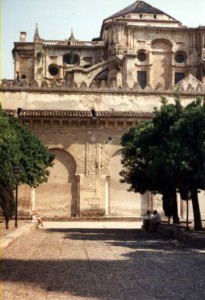(This was a post from 2006 originally on NCOBrief.com … about the end of empire-slash-hegemony, and the unforeseen results from that kind of event. So – if the Presidency of Obama, an event lauded high and low especially in Western Europe – eventually means the end of the American hegemony in various spheres – what then, replaces it? What happens when the US Navy no longer patrols certain ocean choke-points, and local piracy reigns supreme? Will another international power … step to the fore? What then, oh wolves?)
The stone ruins of Imperial Rome underlie Western Europe and the Mediterranean like the bones of a body, partially buried, yet here and there still visible and grandly manifest above ground, all but complete. From Leptis Magna in North Africa, to Hadrian’s Wall in the contentious border between Scotland and England proper, from Split in the Former Yugoslavia, to the 81 perfectly preserved arches of the ancient bridge over the Guadiana River, in Merida – that part of the empire called Hispania – and in thousands of lesser or greater remnants, the presence of Rome is everywhere and inescapable. The same sort of cast – concrete walls, faced with pebbles, or stone or tile, the same sort of curved roof-tiles, the same temples to Vesta, and Jupiter, to Claudius, Mars and Mithras; the same baths and fora, market-places, villas and apartment buildings, all tied together by a network of commerce and administration. Goods both luxury and otherwise, adventurous tourists, soldiers and civil administrators – the very blood of an empire, all moved along the veins and arteries of well-maintained roads and way-stations, of which the very beating heart was Rome itself. Carrying that image a little farther than absolutely necessary, I can visualize that heart as being a human, four-chambered one; of which two – the political/imperial establishment, and the flamboyantly military Rome of battles and conquest – have always rather overshadowed the other two in popular imagination. Commerce and civil administration just do not fire the blood and imagination – unless one is wonkishly fascinated by these things, and it would take a gifted writer to make them as interesting as imperial intrigues and soldiering adventures.
But close to the Palatine Hill, where the sprawling palace of the emperors looked out over the linked fora, law courts and temples in one direction, and the Circus Maximus in another – Trajan’s concrete and brick central market rambled over three or four levels, from the great hall of the Corn Exchange down to the open plaza of the meat market at the level of the forum below . Here was the embodiment of the great hearts’ economic chamber. Every sort of imaginable commodity moved from one end of the empire to another and from parts outside the Roman hegemony: corn from the Egyptian breadbasket, silk from faraway China, spices from India, African ivory and gold, olive oil, oranges and wine from the Mediterranean to everywhere else. And that trade was enabled by law and technology. Roman roads, waterworks, and civic infrastructure like harbors, lighthouses and bridges would in some cases, not be equaled or bettered until the 19th century. While emperors and soldiers came and went, sometimes with messy and protracted splatters of blood, the unspectacular and dull work of the empire went tirelessly on and on, little changing from day to day, decade to decade, until Rome itself seemed eternal, fixed forever, immutable like the stars in the sky.
Read more
which we decided to watch the other night. Beautiful-looking movie, scenic panoramic sweeps of the Northern Plains, attractive and interesting actors especially those portraying Sioux and as for the look and conduct of the tribe as portrayed? I’ve always thought there was nothing better for getting an idea of what a Sioux village and its inhabitants looked like in the mid-19th century. No, really it was marvelous, almost a living history exhibit; everyone was always doing something; working, recreating, celebrating. Alas everything else about Dances just falls apart on closer examination.
